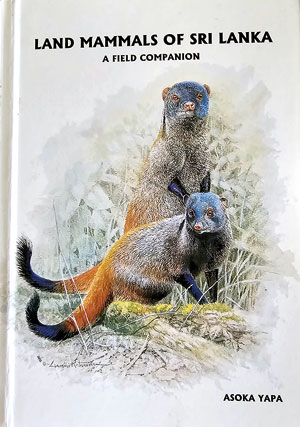News
From shrew to elephant: a handy field guide to our land mammals
View(s):By Malaka Rodrigo
“Imagine how many people in the tourism industry would be out of work without Leopards, Asian Elephants, Sloth Bears, Spotted Deer, Jackals, and other charismatic Mammalian species that make Sri Lanka’s wildlife experience so compelling,” says Asoka Yapa, author of the newly released “Land Mammals of Sri Lanka: A Field Companion.” “These animals bring in millions in foreign exchange—vital for our economy—yet few realise that all of them are mammals.”
Yapa, speaking to the Sunday Times, expressed concern over how little today’s politicians understand the vital economic role played by wildlife. “They prefer headline-grabbing, unscientific statements about so-called ‘pest’ species like Elephants, Porcupines, and Toque Macaques,” yet there is much wealth in diversity of mammals that Sri Lanka need to conserve, he said. 
Mammals are warm-blooded vertebrates that have hair or fur and feed their young with milk. Sri Lanka is home to about 110 species of land mammals, from large charismatic megafauna to lesser-known but ecologically essential species.
Yapa points out that while high-profile mammals attract tourists and funding, other small creatures too play critical roles in maintaining ecosystems. Bats consume millions of insect pests and pollinate fruit trees, mongooses control venomous snakes, jackals manage rodent populations and clean up carrion, and squirrels help select and spread seeds.
His new field guide features all known land mammals of Sri Lanka, illustrated by the internationally acclaimed artist Gamini Ratnavira. It serves as a more portable alternative to the earlier 500-page volume Mammals of Sri Lanka, authored by Yapa and illustrated by Ratnavira which was published by the Field Ornithology Group of Sri Lanka (FOGSL) in 2013. This was hailed as a comprehensive effort to update Sri Lanka’s mammalian diversity, following the first major work on the subject, Mammals of Ceylon by W.W.A. Phillips, published in 1935.
“I wanted to create a field-friendly guide that would help Sri Lankans appreciate our rich mammalian biodiversity and understand the ecological roles of different species,” said Yapa. He also highlights the neglect of smaller mammals, particularly bats, shrews, and rodents—some of which haven’t been recorded in decades. “They’re tiny, nocturnal, and hard to study. But they’re just as vital to the web of life as the iconic species,” he added.
Experts agree that habitat loss is the biggest threat to Sri Lanka’s mammals. While poaching occurs, it hasn’t reached the industrial scale seen in Africa or parts of Southeast Asia.
Yapa hopes the new guide will spark interest in mammal research, especially among youth. All proceeds from the book will go to the Wildlife Conservation Society of Galle to support conservation work.
“There are fascinating mammals even in your own home garden—from the Three-striped Squirrel to mongooses, the Palm Civet (Toddy Cat), and various bats,” Yapa says.
A copy of Land Mammals of Sri Lanka: A Field Companion, can be ordered by calling 0741151115 (Wildlife Conservation Society of Galle).
The best way to say that you found the home of your dreams is by finding it on Hitad.lk. We have listings for apartments for sale or rent in Sri Lanka, no matter what locale you're looking for! Whether you live in Colombo, Galle, Kandy, Matara, Jaffna and more - we've got them all!

